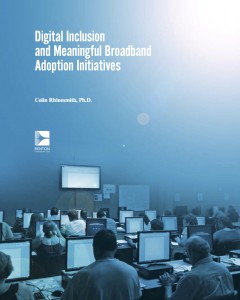 I am thrilled to announce the release of my new report for the Benton Foundation, titled “Digital Inclusion and Meaningful Broadband Adoption Initiatives.” The executive summary and a link to the full report are available on the Benton Foundation’s website.
I am thrilled to announce the release of my new report for the Benton Foundation, titled “Digital Inclusion and Meaningful Broadband Adoption Initiatives.” The executive summary and a link to the full report are available on the Benton Foundation’s website.
Research for the report began late last July, when I started my travels across the US to look at how nonprofit organizations are helping individuals and families gain access to low-cost broadband and digital literacy training. Broadband adoption continues to be a significant problem in the US. The Pew Research Center recently reported that only 67% of Americans have broadband Internet service at home (down from 70% in 2013). In analyzing the data, with research assistance from Aileen Barton at the University of Oklahoma School of Library and Information Studies, I discovered the following four digital inclusion activities were necessary for helping low-income individuals and families to adopt broadband in ways that were most appropriate to their personal needs and contexts:
- Providing low-cost broadband;
- Connecting digital literacy training with relevant content and services;
- Making low-cost computers available; and
- Operating public access computing centers.
The goal of the report is to help policymakers at the local, state, and federal levels, as well as researchers, practitioners, and other key stakeholders, gain a deeper understanding of how digital inclusion organizations and their community partners can be successful in their efforts to promote meaningful broadband adoption.
I am extremely thankful to the following people who helped make this report possible, including: Aileen Barton (University of Oklahoma School of Library and Information Studies), Jane Blackwood (Axiom Training & Education Center), Juanita Budd (Austin Free-Net), Greta Byrum (Resilient Communities Program at New America), Bill Callahan (Connect Your Community 2.0), Jill Castek (Portland State University), Susan Corbett (Axiom Technologies), Dharma Dailey (University of Washington), Colleen Dixon (Free Geek), Cindy Gibbon (Multnomah County Library), Wanda Davis (Ashbury Senior Community Computer Center), Michael Liimatta (US Dept. of HUD, previously Connecting for Good), Drew Pizzolato (Portland State University), Diana Rodriguez (Youth Policy Institute), Angela Siefer (National Digital Inclusion Alliance), Casey Sorensen (PCs for People), and Kevin Taglang (Benton Foundation).
Most importantly, I want to thank all of the individuals and families across the country who shared their broadband experiences with me and provided their recommendations (included in this report) to policymakers at the Federal Communications Commission, the White House, and in Congress, who are working on solutions to the problems facing low-income Americans in gaining affordable and reliable access to broadband.
